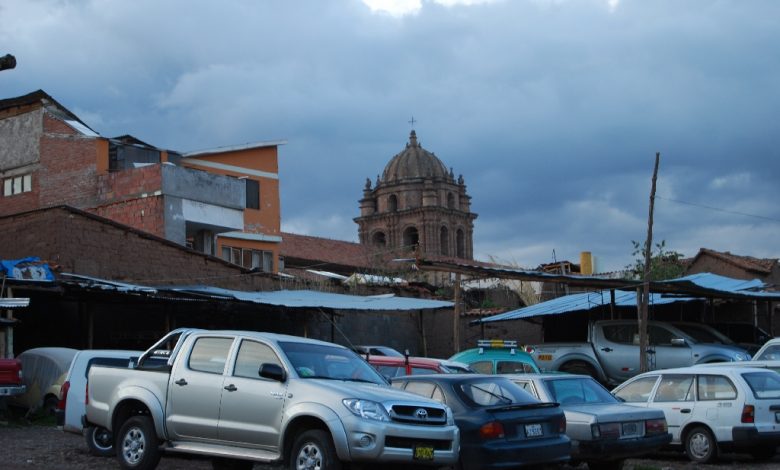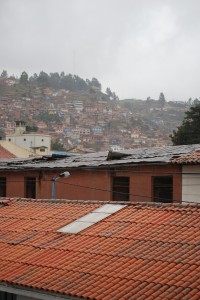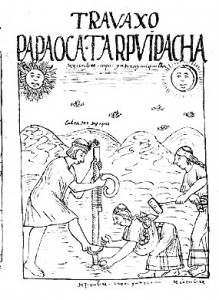September: Rain, Pestilence, and Planting

Rain falls again in Cuzco. The clouds thicken, softening the intense, highland light, like soil well dug and prepared for seeds to sprout. No longer can people walk the streets without drops moistening their face; they find themselves having to stop and wait for cloudbursts under colonnades and overhangs, or simply enjoy more the inside space, like seeds in the ground preparing to burst from the soil in green.
The annual change of seasons is upon us: to rain from bright, sunny and dry–the time most tourists know– when one can walk the streets with abandon. A time of feasting and celebration while the earth rests and the sun glows bright becomes a meditative time of softened, though warmer light and lots of patience while waiting for the rain to stop. It is also a time when the hills change dress, from the drab tan and brown of natural alpaca fibers to the bright green of growth and the rainbow of flower’s colors, as if a traditional weaving, a lliclla, the omnipresent carrying cloth, draped itself over the hills and valleys.
But this time of change traditionally is a time of hunger. The stores of last years potatoes are growing spongy and scarce. Little dried corn remains. Animals are lanky and thin while new pasturage begins to rise above the ground’s surface. New edible greens have yet to reach a size enabling their harvest, and stomachs feel closed and tight.
At least that is how it was when the chronicler Guaman Poma de Ayalla wrote about the month called Sara Tarpuy, the time of corn planting, and identified with September (quote in Millones and Millones) It is still that way for many rural families who live from what they produce on the mountains and in the valleys of Cuzco.
But for families who live on cash, the markets still bring in produce carried over highways in loaded trucks from the lowland tropics or the irrigated desert coast. Neighborhood markets and the supermarkets that are beginning to sprout like mushrooms after a capitalist rain still have fresh produce and lots of packaged goods.

The time is different. Hunger is not felt as much, though the rains make people stay inside more.

But for those who work seasonally in tourism this is a lean time, since incomes shrink as the hordes of North Americans and Europeans on vacation dry up just when the clouds thicken. No longer caused by the sun and rain, as harvests are made, stored, and used, a shrinking stomach comes from other people’s work schedules.
Guaman Poma writes of this as a season of pestilence and even death. He says “There is a lot of rheumatism and gout, as well as heart problems and other illnesses brought by the winds” and we might add rains. (Millones and Millones p. 107) Colds seem to race from person to person with each down draft from the thunderstorms.
Bernabé Cobo writes that in this month the Inca would gather together for the festival of Citua. They would try to drive sickness and evil from the city of Cuzco and down the rivers to the ocean. At the end of the vigorous part of the ritual they would eat a corn gruel and smear it while warm on their faces and door posts, in recognition of the importance of corn and its transformative sacredness.
Today, though the rains are arriving, planting corn is still a matter of celebration.

Here is the master of the charango cusqueño, Don Julio Benavente Díaz performing a song about it in Quechua. (At first the narrator describes the issue in French and then, about a minute in, Don Julio begins playing in the vey distinctive way of the Cuzco-style charango with its shimmering sounds like a ray of sun breaking through the seasonal clouds, something almost never heard in the tourist restaurants on the Plaza where “Andean music” dominates instead.)
Not only is this ritual performed near Cuzco, but takes place throughout the Andes wherever corn is grown. Here is a video (in parts one and two) of the celebration and planting in Cabanaconde in neighboring Arequipa.
Not only is there lots of music and dancing to strengthen the fertility of the fields and the growth of corn plats from the seeds, the community members visit the cemetery to make offerings to the dead. As seeds lie underground waiting to be reborn, there is a relationship with the dead. The people also eat a community meal to share solidarity and to ask the earth for a good year.
In addition, the dances have lots of circular movement like the wind. Though Guaman Poma attributes illness to the wind, it and the rain it brings is important for fertility and the people model it and create it through their dancing.
The clouds gather and rain will fall. Though there will be breaks, still the time of rain has come to Cuzco as one thing leaves and another returns like an endless round.




